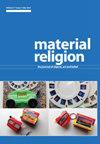Turku Cathedral Museum: Two Exhibitions Displaying the Material Heritage of the Cathedral
IF 0.4
3区 哲学
0 RELIGION
引用次数: 0
Abstract
Abstract The aim of the study is to consider Turku Cathedral Museum, founded in 1929 and reopened in 1982, from a museographical perspective, and to differentiate its spatial structuring and display types with relation to the ecclesiastical museum exhibitions of its time. The exhibitions are interpreted within the context of material heritage and its temporality. The museological value of each object can be shown to constitute an epistemological basis that links exhibition designers Juhani Rinne and Riitta Pylkkänen, who belong to different scholarly generations. The first exhibition of 1929 consisted of artifacts such as medieval sculptures, liturgical textiles, and vessels, as well as documentary objects such as miniature scale models and drawings that illustrated the church’s architectural construction. Numerous exhibits consisted of finds from the archaeological excavations that were conducted during the 1920s as part of the building’s restoration works. Assisted by a guidebook, visitors were able to make individual guided tours through the exhibition, which was situated in the cathedral’s south gallery and in its chapels. The exhibition closed in 1960, and the artifacts were placed in storage. The museum opened again, after a complete renovation, in 1982, keeping its position in the south gallery. Items were presented primarily within protected display cases, and the exhibition featured a greater number of textiles, silverware, and liturgical objects dating from a period of several centuries. Modern, technical solutions were developed to ensure that objects were maintained in conditions suitable for their preservation. It was decided that the most fragile and delicate textiles would be kept apart within a research collection.图尔库大教堂博物馆:展示大教堂物质遗产的两个展览
本研究的目的是从博物馆学的角度来考虑图尔库大教堂博物馆,该博物馆建于1929年,1982年重新开放,并将其空间结构和展示类型与当时的教会博物馆展览区分开来。展览是在物质遗产及其时间性的背景下进行解释的。每件物品的博物馆学价值都构成了一个认识论基础,将展览设计师Juhani Rinne和Riitta Pylkkänen联系在一起,他们属于不同的学术时代。1929年的第一次展览包括中世纪雕塑、礼拜用纺织品和器皿等文物,以及说明教堂建筑结构的微型模型和图纸等文献物品。许多展品包括20世纪20年代进行的考古发掘的发现,作为建筑修复工程的一部分。在导游手册的帮助下,参观者可以通过位于大教堂南画廊和小教堂的展览进行个人导游。展览于1960年结束,这些文物被存放在仓库里。1982年,经过全面整修后,博物馆重新开放,保留了它在南画廊的位置。物品主要在受保护的陈列柜中展出,展览展示了大量的纺织品、银器和几个世纪以来的礼仪物品。现代的技术解决方案被开发出来,以确保文物保存在适合它们保存的条件下。我们决定将最脆弱和精致的纺织品分开保存在研究收藏中。
本文章由计算机程序翻译,如有差异,请以英文原文为准。
求助全文
约1分钟内获得全文
求助全文

 求助内容:
求助内容: 应助结果提醒方式:
应助结果提醒方式:


